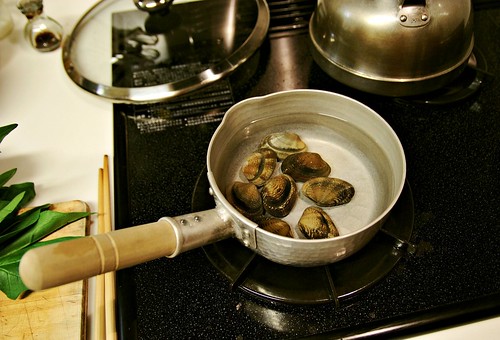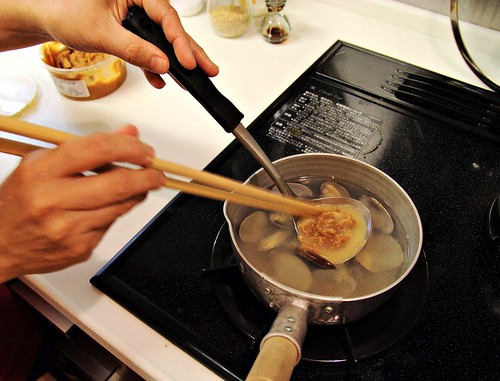But not this time. This is a very Japanese miso soup, and I know for a fact that it is fairly easy to make in Sweden (and in most parts of the world). First, though, some info on the (non)ingredients.
Miso
The only specifically Japanese ingredient here is miso paste. Miso is a crushed, moist paste of soy beans and/or rice that have been fermented and then salted. As with anything traditional there's a huge amount of specialized knowledge to be had for those with an interest (take a look at the Wikipedia entry) but really you only need to know that the longer it ferments the darker it gets. And the darker it gets the "darker", smokier and fuller (and less salty) is the taste. Really light miso, pale yellow in color, may have fermented for a month or so, while the darkest types may have been aged for a year.
Which kind to use is mostly a matter of taste. At my current place of work you pick up a bowl with the soup ingredients and fill it with the miso flavour of your choice from a vending machine (no, the Michelin guide is not going to come knocking at this cafeteria anytime soon). It's not just used for soup, but can be used as a spice or ingredient in all kinds of food (try pickling fish fillet's or pork chops in miso for a few hours before frying them). Miso is very durable; if you keep it in an airtight container it'll keep for a year.
Dashi
Most forms of soup is based on "dashi", a light unsalted broth made from seaweed, dried fish and/or dried mushroom. Of course, most Japanese don't bother making it from scratch (it's easy enough, but it takes time), and instead use some form of instant powder, just like you normally buy stock rather than make it yourself. But unlike miso, instant dashi does not seem to widely available in Sweden, and it is ridiculously, hideously expensive when you do find it. The ingredients needed to make your own (the right kind of konbu seaweed, katsuobushi and so on) are also hard to find.
Note that some brands of miso have dashi powder already mixed in. This is convenient when you just want to make a soup, but means the miso is not really useful for any other cooking. So for this recipe I'll show a form of miso soup that doesn't use dashi at all. Or rather, we let the main soup ingredient, clams, provide the stock as it cooks.

Figure about four clams and perhaps 3dl water per person. Cook the clams until they open (about 3 minutes or so). As always, don't use clams that don't close when you tap on them, and remove clams that never opened after cooking.

Then take some miso paste, perhaps a heaped tablespoon per person into a ladle and mix the miso with a bit of the soup in the ladle. The reason is not some mystic eastern ritual but simply that miso is not very water soluble and if you just dump it straight into the pot you'll end up with clumps of miso in the soup.

Let it simmer (not boil) for a few minutes, pour it into bowls with the clams and add some garnish. Doesn't get much easier than that.
We often use mitsuba in this soup, but feel free to experiment with any herb or leaf; chives goes well with this too, for instance. You can also add croutons or beansprouts to good effect. Tofu is common in miso soup but avoid it here; the clam shells ends up crushing it during cooking.

No comments:
Post a Comment
Comment away. Be nice. I no longer allow anonymous posts to reduce the spam.